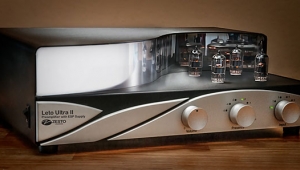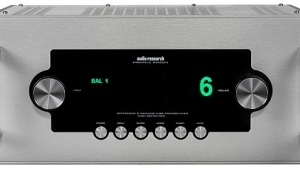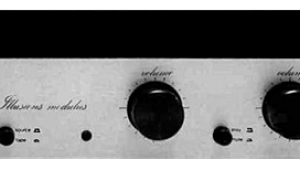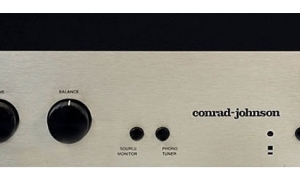| Columns Retired Columns & Blogs |
Blue Circle BC3 Galatea line-level preamplifier
Ideally, through the medium of a synergistically balanced set of high-resolution components, we seek to re-create an acoustic event with a palpable sense of realism—as in timbre, dynamics, room cues, and dimensionality. Have I ever experienced a system commensurate with the experience of sitting 12th-row-center at Carnegie Hall for Boulez conducting Stravinsky? Close, but...
 By the same token, I've enjoyed musical epiphanies—a sense of otherness—in my own humble listening abode that were sonically far more intimate, detailed, and satisfying than the average live presentation. Thus, over time, I've come to realize that the more effluvia you can wash away, the more directly you can approach the music, the deeper the experience of immersion, be it in the concert hall or your living room.
By the same token, I've enjoyed musical epiphanies—a sense of otherness—in my own humble listening abode that were sonically far more intimate, detailed, and satisfying than the average live presentation. Thus, over time, I've come to realize that the more effluvia you can wash away, the more directly you can approach the music, the deeper the experience of immersion, be it in the concert hall or your living room.
And so, after spending the better part of the past year journeying through the land of integrated amps, I finally got to spend a significant period of time with a true high-resolution preamplifier, the Blue Circle BC3.1—which, when paired with the new deluxe BCG3.1 power supply, is marketed as the Blue Circle BC3 Galatea.
"Simplicity, Artistry, Music" is the working philosophy of Blue Circle designer Gilbert Yeung, whose company has been crafting handmade amplifiers, preamplifiers, power-line conditioners, phono stages, line-level signal transformers, power cords, speaker cables, and accessories in Ontario since 1990, all the while developing formidable word-of-mouth among audiophiles for attention to detail and musical refinement.
From the moment I hooked these units up, the captivating turquoise glow of their matching front-panel lights (a glowing orb within a blue circle) held out the promise of something inviting and serene.
Who made off with the preamp?
When I first unpacked the BC3 Galatea, I was struck by the simple, understated elegance of its nonmagnetic stainless-steel case and red-cherry hardwood volume controls, input selector knobs, and tripod footers; by the 4-pin XLR power supply connector on the back center, flanked by discrete mirror-imaged arrays of five dual-mono right/left channel inputs and two main outs, with separate tape inputs and outputs (all Cardas gold/rhodium RCA jacks); and by the solid, beefy build of the power supply with its IEC inlet, XLR cable port (for the Cardas BC-7C DC power interconnect cable), and power switch. Everything about them seemed to say, "Here I am, just what you need—no more, no less."
This impression was further affirmed when I undid the four side-panel thumb screws, slid off the top cover, and espied the two 6922 triode tubes and the point-to-point wiring on the 0.25"-thick blue acrylic circuit board, mounted on four spring-loaded columns on a pre-compressed spring assembly for mechanical isolation. I removed the upper pair of transport nuts/washers and spun the lower transport nuts so that its washers separated from the board. Looking around the case, I was struck by the seeming paucity of parts, and chuckled silently to myself: "Gee, somebody made off with the preamp—it's an empty box."
Gilbert Yeung chuckled knowingly. "Why use all those parts? Are they trying to make the consumer think they paid that much money and it was worth it? Or are they trying to make something that actually will pass through original signals as musically as possible? Are you buying the parts or are you buying the music? If you are buying the music, you want the thing as simple as possible so the signal doesn't have to pass through thousands of feet of wire and circuit board. I try to put as few things as possible in the signal path. As a matter of fact, each channel on the Galatea has only five resistors. We pay attention to these details, and the result is cleaner, purer, more musical."
This attention to small details is particularly evident in the matched pair of 31-step, true mono, Shallco ladder attenuators that function as volume controls for each channel, each hand-assembled from matched pairs of metal-film resistors. Each of the 31 contact points is self-cleaning and constructed from military-grade coin silver. Conventional volume controls seem downright crude—it's like the difference between turning a faucet on full and letting the water flow through a drop at a time. I was able to find an optimum point where the gain stage of the system really matched up with the gain of the source. I didn't necessarily have to play everything so full-out loud, and the resulting resolution at the lowest volume levels was exemplary.
"When you turn the volume down on normal volume controls, the signal has to pass through more physical paths," Yeung explains. "But on a ladder attenuator, it doesn't matter where your volume-control position is or where your attenuator position is, the signal still only goes through one [series] resistor—again, the shortest, simplest signal path. If possible, then I would rather take it out because that means one less thing in the signal's path—a more simple circuit."
Simplicity of design, directness of signal path, and a minimum of parts—these are benchmarks of the Blue Circle philosophy, and help explain the logic and performance implications behind any number of Yeung's design decisions. Why employ a polarity-inverted design? That way, you can eliminate an extra gain stage (and, if employing a non-inverting power amp, simply go positive to negative, negative to positive with the speaker connections). Why invest an extra $1350 in the hefty, double-transformer BCG3.1 external power supply? Faster transients, 6dB less noise, blacker backgrounds, greater soundstaging depth, and more stable images. Class-A? To achieve the ideal bias point and optimum linearity in the gain stage. Only two tubes? The front tube's pair of triodes are shared by the two channels as the voltage-gain stage; the rear tube's triodes are shared as the buffer stage, so temperature and voltage changes occur evenly in both channels at the same time.
- Log in or register to post comments




































